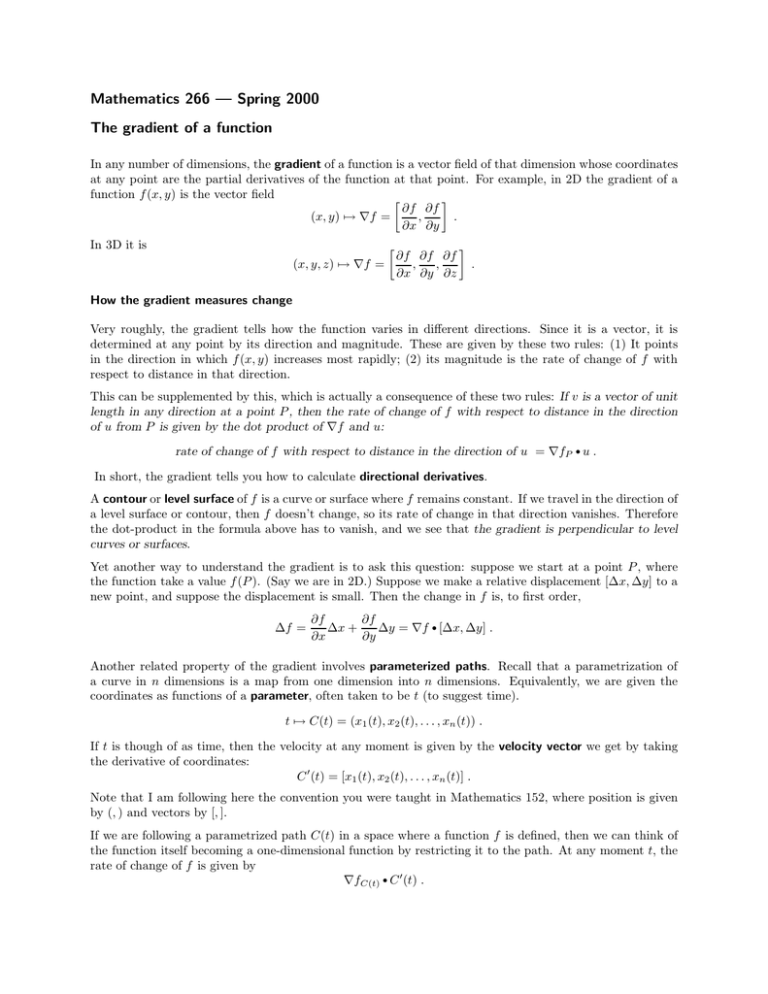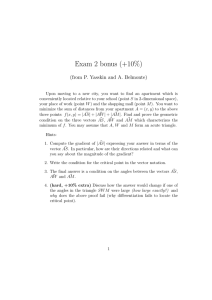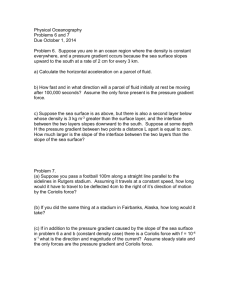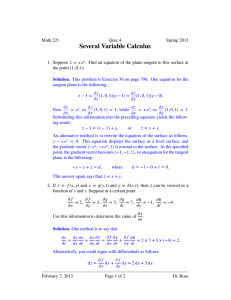Mathematics 266 — Spring 2000 The gradient of a function
advertisement

Mathematics 266 — Spring 2000 The gradient of a function In any number of dimensions, the gradient of a function is a vector field of that dimension whose coordinates at any point are the partial derivatives of the function at that point. For example, in 2D the gradient of a function f (x, y) is the vector field ∂f ∂f , . (x, y) 7→ ∇f = ∂x ∂y In 3D it is ∂f ∂f ∂f , , (x, y, z) 7→ ∇f = ∂x ∂y ∂z . How the gradient measures change Very roughly, the gradient tells how the function varies in different directions. Since it is a vector, it is determined at any point by its direction and magnitude. These are given by these two rules: (1) It points in the direction in which f (x, y) increases most rapidly; (2) its magnitude is the rate of change of f with respect to distance in that direction. This can be supplemented by this, which is actually a consequence of these two rules: If v is a vector of unit length in any direction at a point P , then the rate of change of f with respect to distance in the direction of u from P is given by the dot product of ∇f and u: rate of change of f with respect to distance in the direction of u = ∇fP • u . In short, the gradient tells you how to calculate directional derivatives. A contour or level surface of f is a curve or surface where f remains constant. If we travel in the direction of a level surface or contour, then f doesn’t change, so its rate of change in that direction vanishes. Therefore the dot-product in the formula above has to vanish, and we see that the gradient is perpendicular to level curves or surfaces. Yet another way to understand the gradient is to ask this question: suppose we start at a point P , where the function take a value f (P ). (Say we are in 2D.) Suppose we make a relative displacement [∆x, ∆y] to a new point, and suppose the displacement is small. Then the change in f is, to first order, ∆f = ∂f ∂f ∆x + ∆y = ∇f • [∆x, ∆y] . ∂x ∂y Another related property of the gradient involves parameterized paths. Recall that a parametrization of a curve in n dimensions is a map from one dimension into n dimensions. Equivalently, we are given the coordinates as functions of a parameter, often taken to be t (to suggest time). t 7→ C(t) = (x1 (t), x2 (t), . . . , xn (t)) . If t is though of as time, then the velocity at any moment is given by the velocity vector we get by taking the derivative of coordinates: C 0 (t) = [x1 (t), x2 (t), . . . , xn (t)] . Note that I am following here the convention you were taught in Mathematics 152, where position is given by (, ) and vectors by [, ]. If we are following a parametrized path C(t) in a space where a function f is defined, then we can think of the function itself becoming a one-dimensional function by restricting it to the path. At any moment t, the rate of change of f is given by ∇fC(t) • C 0 (t) . Gradients and physics 2 Gradients and physics The importance of gradients in physics is that a field in which potential energy invariably has associated with it a force field. The exact rule, say in 3D, is that if f (x, y, z) is the PE at a point then the force field associated with it is −∇f . The negative sign is there because in increasing potential energy we must struggle against the force in order to do work—the force must be in direction opposite to potential energy increase. We can analyze this in more detail. Suppose we follow a path in any force field F field (not necessarily a gradient), going from one point to another. The motion can be thought of as a string of very small displacements along pieces which are almost straight line segments. If we make a displacement ∆s = [∆x, ∆y] then we do work against the field. Recall that work is equal to the product of force and distance. The distance gone is p k∆sk = ∆x2 + ∆y 2 The magnitude of the force we are fighting is the component of the force field in the direction of the displacement, which is kF k cos θ if θ is the angle between the force field and the displacement. The formula for cos θ is F • ∆s . kF k k∆sk The work done is therefore kF k k∆sk F • ∆s = F • ∆s . kF k k∆sk The work done over the whole curve is then the sum of all these bits of work, which becomes the integral Z − Q P F • ds . If we parametrize the path this becomes the ordinary integral Z − tQ tP F (C(t)) • C 0 (t) dt . The sign is - because we are measuring done on the object against the force. The main point is that this integral depends only on the geometry and the force field, not on the particular parametrization. This argument works for any force field at all. If it is the gradient of a potential energy, sya F = ∇f , then this comes Z tQ Z tQ df 0 dt = f (P ) − f (Q) F (C(t)) • C (t) dt = − tP tP dt which is to say that the work done equals the gain in PE.







